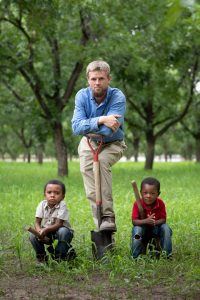In today’s podcast we look at the synergistic collaboration between a soil scientist and a pecan farmer.
Southern New Mexico is not an ideal landscape for pecans, which grow best in warm, wet climates. But the industry is here, and Josh Bowman has determined to grow a healthy and abundant crop by focusing on the soil. Using cover crops and grazing animals, he’s been able to increase the life and organic matter in the soil, and to produce a greater yield and a higher quality nut—while using less water.

David Johnson was a contractor who at mid-life decided to change careers and became a microbiologist, specializing in the soil microbiome. He collaborates with farmers like Bowman to increase the quality—and quantity—of the soil with an eye not only to improved health and profits for the farmer, but also to climate change mitigation as carbon is sequestered in ever-healthier soils. Johnson and his wife Hui-Chun Su developed the Johnson-Su bioreactor, a composting system that yields a potent, microbe-rich compost that is a soil-friendly and cost-effective alternative to synthetic fertilizers.

This interview is part the Good Earth series, a project supported by the New Mexico Department of Agriculture Healthy Soils Initiative and led by photographer Esha Chiocchio. It features a set of eight videos on soil stewards in New Mexico. Please check out the short videos here.
Photos by Esha Chiocchio for the Good Earth project
Podcast timeline
1’23 how Josh started farming
2’17 learning some innovative practices from his family
3’04 wanting to have plants rather than brown dirt under the trees
3’28 “if you want to make big changes, change how you see things”
4’16 2018 started doing regenerative practices on the whole farm
5’08 regenerating the soil to pre-European settlement health
5’24 NM used to be grassland, not desert
5’57 restoring to pre WW2 soil
6’42 cowboy records of grasslands
7’01 we overgrazed the land, but it can be reversed
7’23 soil was a bank account that they drew on but didn’t replenish
7’47 Gabe Brown has shoulder-high grass with 5″ of rain
8’39 how to think about pecan farming in a semi-arid climate
9’06 making orchard soil more like a forest floor
9’56 inputs down, yields up
10’18 started planting cover crops
10’45 contrast to “conventional” pecan farms; they do less tillage and more growing plants
11’15 contents of cover crops
11’38 importance of diversity
12’00 summer mix
12’19 sampling the soil
12’37 annual soil testing reveal that organic matter is going up significantly
13’14 what happens when soil organic matter increases–how it’s used in soil
13’35 increasing the microbes
14’00 the more carbon and microbes in the soil, the more productivity and the more profit
14’24 1% increase in soil organic matter quintuples the amount of water that can be retained in the soil
14’55 water retention is key for pecan growing
15’23 using more water to establish the cover crops and then they start to use less as they mature
15’43 cover crops keeping the soil a lot cooler—by 25-35°
16’14 building a deep profile of topsoil; they want to go from a few inches to a few feet in the next 20 years
16’52 they’re doing the opposite of erosion
17’26 “conventional” farms have standing water and poor drainage
17’5 synthetic nitrogen fertilizer compacts the soil and makes it the water problem worse
18’27 getting more crop per unit of water
18’44 using even small amounts of water
19’01 what do you tell other farmers who are using poor practices
19’18 there’s not one thing that solves the problem. you need a systems approach
19’5 the importance of continual observation
20’2 grazing animals on the cover crops–the missing link to build organic matter faster
21’05 moving the livestock daily
21’16 the importance of trampling as well as eating the cover crops
21’45 intensive rotation grazing at one acre per day
22’31 animals get moisture from the crop so they don’t need to provide as much water
22’57 kids love livestock
23’21 taking shovels on the walk with the kids and looking for worms
23’57 the importance of seeing and smelling the soil
24’14 taking regeneration into other parts of your life
24’52 worms as indicators of healthy soil
25’54 pecan quality and quantity–quantity has increased 25% through regenerative practices
26’53 you can increase quality AND quantity
27’14 David was a contractor before he was a scientist
28’16 realizing as a scientist that your work can make a real difference locally and globally
29’12 the societal impact of nitrogen fertilizer for corn is more than three times as high as the profit on that corn
30’58 new composting system came from the fact that his clothes were covered in manure and his wife said there has to be a better way to do it
31’26 having compost that doesn’t get turned
32’46 compost acting as a microbial innoculant to bring back soil–and two pounds per acre is sufficient
33’33 the bioreactor has gone global
34’25 restoring the microbial communities in our bodies and in our soils
35’27 regenerative food is healthier
35’40 Josh is using the composting system
35’58 scientists and farmers learning from each other
36’23 nature is the result of trial and error
36’54 the role of soil in mitigating climate change–it’s huge
38’32 how his work as a contractor helped him to understand farmers
39’44 consulting with other farmers
40’24 introducing a holistic system has been helpful
41’26 the importance of peer to peer examples
42’17 the costs of transitioning to regenerative practices
42’53 one farmer starts doing a practice and it catches on–leading by example
43’43 if you do it right there doesn’t have to be a cost to transition
44’23 two pounds of compost yields the same results as 256 pounds of fertilizer
45’07 is there a limit to the amount of carbon that soil can sequester
45’24 if you build more soil then absorption continues to rise
46’47 always learning, staying humble



Subscribe:
Apple Podcasts
Spotify